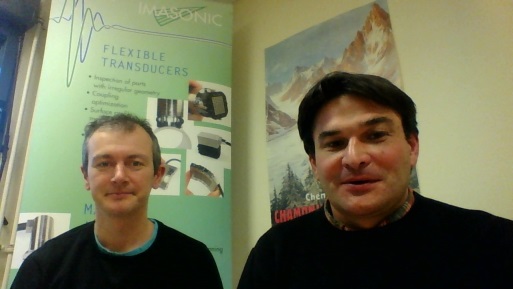Theo Martinez and Philippe Dumas | Imasonic
20th January, 2014
We had the chance to interview Mr. Theo Martinez, Modeling, Testing and Measures Engineer, and Mr. Philippe Dumas, Application Engineer specialized in NDT, both at Imasonic.

You have been using simulation for many years now. Could you explain how simulation helps you in your daily tasks?
Imasonic designs and manufactures ultrasonic sensors for industrial and medical sectors.
We have been using CIVA for over fifteen years, for any kind of probe, in order to help us define their characteristics, and optimize configurations based on objective criteria related to the beam or to the defects response, or to analyze acoustic phenomena.
Imasonic also uses other types of simulation than CIVA. Which ones, and why?
Our profession has two distinct phases. First, defining the parameters of a probe (frequency, size…), and then, defining its electroacoustic structure.
CIVA helps us during the first phase of our work. For the second phase, we use “finite elements” simulation tools to solve multi-physics problems (electro mechanical, thermal…).
We have also developed, for our internal needs, some tools based on semi analytical models, to solve electroacoustic or propagation problems.
What types of sensors are the most looked for on the market now? (What features are the most sought after in a sensor?)
We produce more and more multi-elements probes, linear probes of course but also matrix probes.
We have a line of standard multi-elements probes with already defined characteristics.
But we also realize a large number of custom probes, of any kind (rho, theta, TRL, matrix…) with elements of different shape and size. For these, we adjust the parameters to be the closest possible to the customer’s request.
We use CIVA to optimize the characteristics.
Miniaturization and an increasing number of elements are becoming more and more frequent requests.
Do you think the simulation of a probe via CIVA is rather reliable, and that the parameters for the definition of a sensor are precise enough to define a probe, the closest to reality?
We’ve been using CIVA for a very long time, and like any simulation software, it has its limitations, for example on in-contact T-waves simulation.
The combination of our knowledge of the software and our experience gives us a fairly reliable indication of performance.
It is important to note that a probe is not limited to the cutting of an active surface. It includes a strand of wire, a box containing an attenuating material, and on top of this, possibly different physical constraints related to the application (temperature, radiation, chemical constraints…)…
The definition of a sensor must take into account all of these parameters.
CIVA allows a good approach of the acoustic part, but it is essential to check with a manufacturer the feasibility of the configuration.
